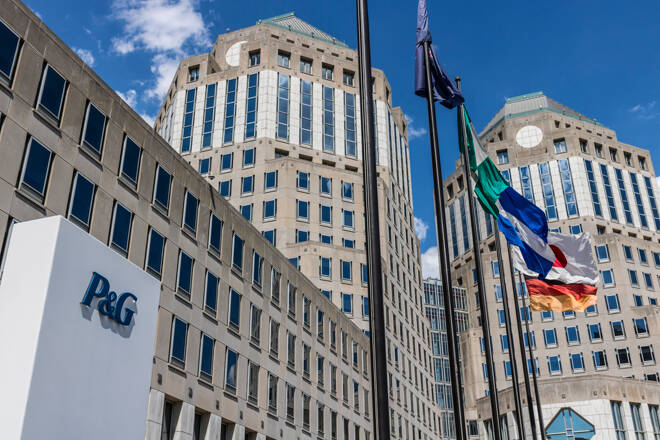Advertisement
Advertisement
Procter & Gamble Shareholders Head For the Exits
By:
Rangebound action is likely to continue well into 2022, forcing investors to rely on the modest dividend yield.
Dow component Procter & Gamble Co. (PG) is trading lower by more than 2% in Tuesday’s pre-market despite beating Q1 2022 top and bottom line estimates. The home and health care giant posted a profit of $1.61 per-share during the quarter, just $0.02 above expectations, while revenue rose a 5.3% year-over-year to $20.34 billion, more than $350 million higher than consensus. The decline confirms the recent failure of September’s breakout above the 2020 peak near 147.
Pandemic Hangover and High Inflation
Revenue is winding down from the 8.5% increase during the same quarter in 2020, when consumers were stocking their shelves in reaction to pandemic disruptions. That marked the strongest growth in years, making 2021 comparisons tough to swallow for sidelined investors. As a result, it isn’t a surprise that 2022 guidance of 3% to 6% revenue growth triggered a sell-the-news reaction even though the company offered the same metrics three months ago.
Inflation is also taking a bite out of profits, with higher production and freight costs reducing earnings-per-share (EPS). In addition, CEO David Taylor is retiring at the end of October, with COO Jon Moeller taking the helm at the start of November. This has added to uncertainty that hasn’t been helped by executive share sales during the quarter, suggesting investors have reached the conclusion this isn’t a good time to buy Procter & Gamble.
Wall Street and Technical Outlook
Wall Street consensus stands at an ‘Overweight’ rating based upon 10 ‘Buy’, 2 ‘Overweight’, 10 ‘Hold’, and 1 ‘Underweight’ recommendation. Price targets range from a low of $139 to a Street-high $167 while the stock is set to open Tuesday’s session on top of the low target. This dismal placement indicates that analysts have failed to calculate the adverse impact of inflation and supply chain disruptions on the 12-month outlook.
Procter & Gamble has been a slow-mover for decades, in line with its defensive reputation. The stock mounted the February 2020 peak at 128.09 in August 2020 and took off in a brief advance that topped out at 146.92 in November. The subsequent decline ended at breakout support in March 2021, yielding a rally that exceeded the prior high by 31 cents in September before turning tail in a decline to the 130s. This rangebound action is likely to continue well into 2022, forcing investors to rely on the 2.41% dividend yield.
For a look at today’s economic events, check out our economic calendar.
Disclosure: the author held no positions in aforementioned securities at the time of publication.
About the Author
Alan Farleyauthor
Alan Farley is the best-selling author of ‘The Master Swing Trader’ and market professional since the 1990s, with expertise in balance sheets, technical analysis, price action (tape reading), and broker performance.
Advertisement
